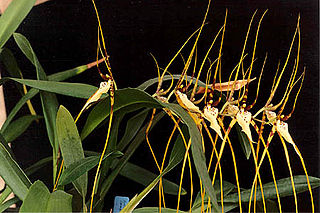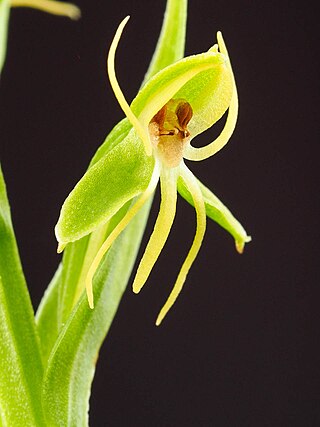
Brassia is a genus of orchids classified in the subtribe Oncidiinae. It is native to Mexico, Central America, the West Indies, and northern South America, with one species extending into Florida.

Miltonia, abbreviated Milt. in the horticultural trade, is an orchid genus comprising twelve epiphyte species and eight natural hybrids. The miltonias are exclusively inhabitants of Brazil, except for one species whose range extends from Brazil into the northeast of Argentina and the east of Paraguay.

Myrmecophila is a genus of plants belonging to the family Orchidaceae. It is native to southern Mexico, Central America, the West Indies and Venezuela.

Aspasia, abbreviated as Asp. in the horticultural trade, is a genus of 7 species of orchids occurring from southern Mexico to southern Brazil. The genus is closely related to Miltonia and Brassia. Aspasia species have few medium size flowers of exquisite colors which are occasionally cultivated or used to produce artificial hybrids.

Brassia keiliana is a species of orchid. It is native to Colombia, Venezuela and Guyana.

Brassia arachnoidea is a species of orchid. It is endemic to the Rio de Janeiro region of Brazil.

Brassia arcuigera, the arching brassia, is a species of orchid. It is native to Honduras, Costa Rica, Panama, Colombia, Venezuela, Ecuador, and Peru. The subspecies B. a. longissima is most notable for its very large flowers; as much as 21 inches wide "tip to tip".

Brassia caudata is a species of orchid. It is found widespread across the warmer parts of the Western Hemisphere, reported from southern Mexico, Central America, southern Florida, Greater Antilles, Trinidad, northern South America. It is also known by the common names tailed Brassia, spider orchid and cricket orchid.

Brassia gireoudiana, or Gireoud's brassia, is a species of orchid. It is native to Costa Rica and Panama.

Brassia lanceana, or Lance's brassia, is a species of orchid. It is native to Trinidad & Tobago, Venezuela, Guyana, Suriname, French Guiana, Colombia, Panama, Ecuador, Peru and northern Brazil.

Brassia macrostachya is a species of orchid native to Venezuela and Guyana.
Brassia pumila is a species of epiphytic orchid native to Guyana, Venezuela, French Guiana, Colombia, Peru, and Brazil.

Brassia maculata, the spotted brassia, is a species of orchid. It is native to southern Mexico, Central America, Cuba, and Jamaica.

Eulophia alta is a species of orchid, known as the wild coco. It is widespread across tropical and subtropical parts of Africa, South America, Central America, Mexico and the West Indies, as well as the southeastern United States.

Oncidium baueri is a species of orchid native to Costa Rica and to South America as far south as Bolivia and Brazil.
Aulosepalum is a genus of flowering plants from the orchid family, Orchidaceae. It consists of 8 species native to Mexico and Central America.
- Aulosepalum hemichrea(Lindl.) Garay - Oaxaca, Chiapas, El Salvador, Guatemala, Honduras, Nicaragua
- Aulosepalum nelsonii(Greenm.) Garay - Michoacán, Oaxaca
- Aulosepalum oestlundii(Burns-Bal.) Catling - Guerrero
- Aulosepalum pulchrum(Schltr.) Catling - Guatemala and southern Mexico
- Aulosepalum pyramidale(Lindl.) M.A.Dix & M.W.Dix - from central Mexico to Costa Rica
- Aulosepalum ramentaceum(Lindl.) Garay - Tamaulipas, San Luis Potosí
- Aulosepalum riodelayense(Burns-Bal.) Salazar - Oaxaca
- Aulosepalum tenuiflorum(Greenm.) Garay - Morelos, Guerrero

Brassia aurantiaca is a species of orchid. It is native to Colombia, Ecuador and Venezuela.

Habenaria repens, commonly called the water-spider bog orchid or the floating orchid, is an orchid species widespread across Latin America from Mexico and the West Indies south to Argentina, as well as in the Southeastern United States from Texas and Oklahoma east to Florida and the Carolinas plus an isolated population in Virginia.

Ponera is a genus of orchids. It contains two currently accepted species, native to Mexico, Guatemala and El Salvador.

Cyclopogon elatus is a species of terrestrial orchids. It is widespread across much of Latin America from Mexico and Belize to Argentina, as well as in the West Indies and southern Florida.

















